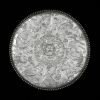
Headdress of the Lady Puabi, ca. 2650-2550 BCE
Gold, lapis lazuli and carnelian (36 cm height of comb, 2.7 cm diameter of hair rings, 11 cm diameter of earrings) University of Pennsylvania Museum of Archaeology and Anthropology
Lady Puabi was interred with numerous handmaidens. She was buried with the finest jewelry and accessories available at the time. Her ornate Headdress, made up of a comb, hair rings, three wreaths, a hair ribbon and double-lunate or crescent-shaped earrings, surmounted an elaborately braided coiffure (possibly a wig) known only from contemporary sculptural representations. It was made from gold, lapis lazuli and carnelian. The level of the headdress' artistic sophistication, with its floral imagery of gold willow and beech leaves, demonstrates Puabi's elevated place in Sumerian society. Seven gold rosettes, suspended over the headdress from a comb, once again reflect the Sumerian preoccupation with vegetation and fertility.

Detail of Lady Puabi's diadem, incorrectly assembled by Woolley in the 1920s from the assortment of ornaments excavated from the Royal Cemetery at Ur.
Woolley's excavation of RT 800 (Queen Pu-Abi's Grave)
The care with which Sir Leonard Woolley excavated the Royal Cemetery of Ur is justly famous, and the difficult conditions under which he worked would prove challenging to even the most skilled archaeologist today. The relationship between graves RT 789 and RT 800 illustrates this point. RT 789 preceded RT 800, as attested by the location of RT 800's "death pit" above that of of tomb RT 789. However (and for unknown reasons), the tomb-cutters decided to sink her tomb chamber deeper into the ground and next to the tomb chamber of RT 789. It is supposed by some that the original occupant of RT 789 was Queen Pu-Abi's king, but because that tomb was plundered in antiquity, his identity is unknown.








